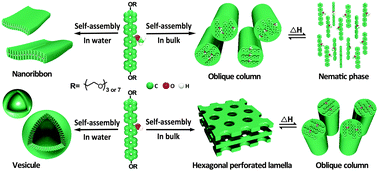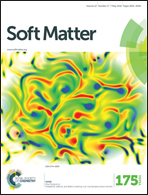Self-organizing p-quinquephenyl building blocks incorporating lateral hydroxyl and methoxyl groups into supramolecular nano-assemblies†
Abstract
The self-assembling behavior of coil–rod–coil molecules 1a, 1b, and 2a, 2b was investigated using DSC, POM, SAXS, and AFM in bulk and aqueous solutions. These molecules contain p-quinquephenyl groups as rod segments incorporating lateral hydroxyl or methoxyl groups in the center positions and oligo(ethylene oxide)s as the coil segments. Molecules 1a and 1b, with lateral methoxyl groups in the rod segments, self-assemble into oblique columnar structures in the crystalline phase and transform into nematic phases. On the other hand, molecules 2a and 2b, with hydroxyl groups in the center of their rod segments, self-organize into hexagonal perforated lamellar and oblique columnar nano-structures in the crystalline and liquid crystalline phase, respectively. In aqueous solutions, these molecules aggregate into nano-ribbons and vesicles, depending on their lateral groups and oligo(ethylene oxide) chain lengths. These results imply that the lateral methoxyl or hydroxyl groups, present in the center of the rod segments, significantly influence the formation of various supramolecular nano-structures in the bulk state and in aqueous solution. This is achieved via tuning of the non-covalent interactions of the rod building blocks.


 Please wait while we load your content...
Please wait while we load your content...